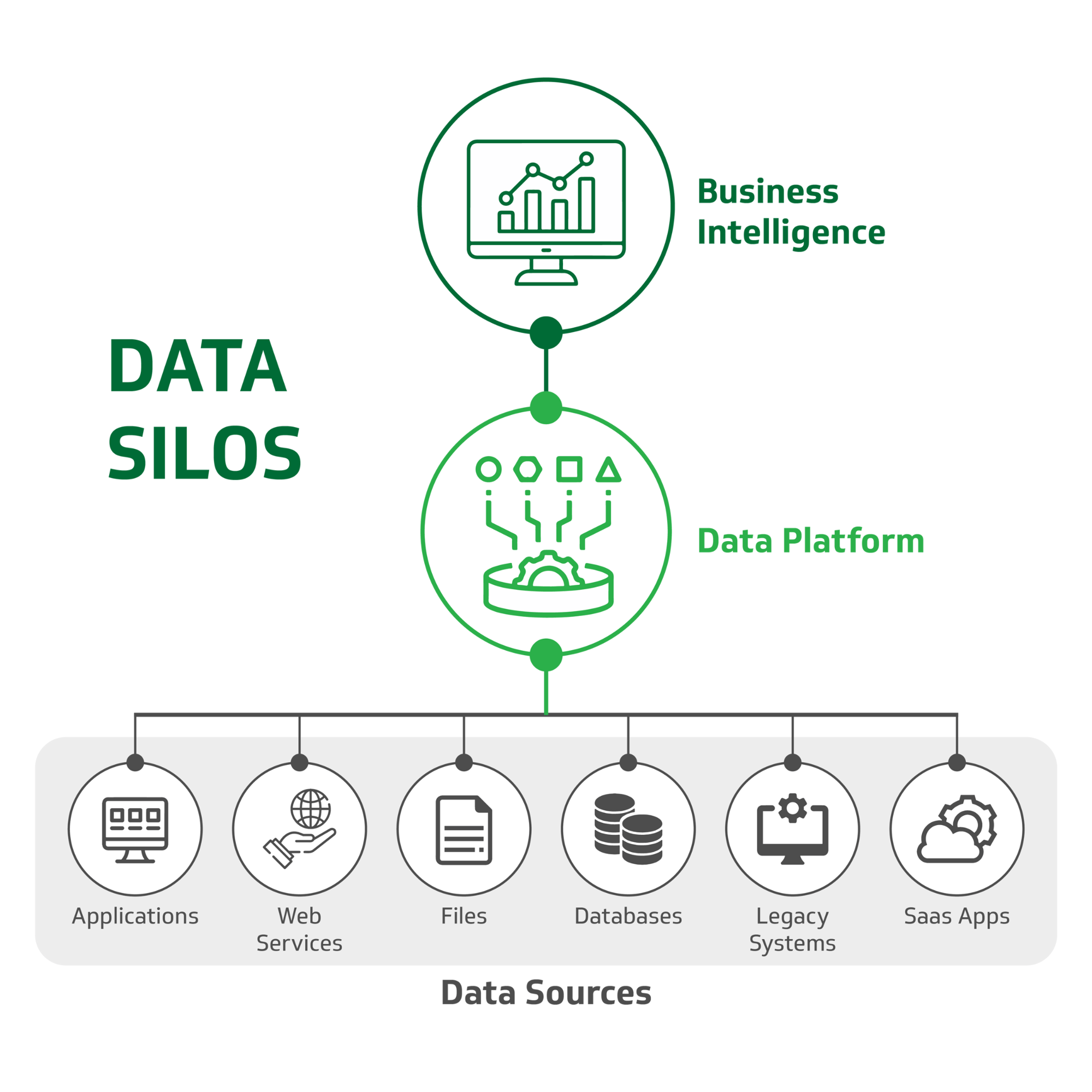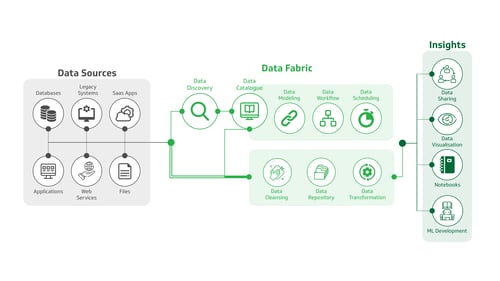Finworks Guide to Breaking Down Data Silos
Data is crucial for an enterprise's day-to-day operations. To harness and bring value from data, silos must be broken down. Data management facilitates an efficient way to collect, process, and enrich critical business data for improved business performance and decision-making.

Section 1: Data Silos: What They Are and How to Get Rid of Them
Section 2: What are Data Silos, and What Problems Do They Cause?
Section 3: Strategies for Overcoming Data Silos
Section 4: How to break down data silos?
Section 5: Case study: From Data Silos to Data Management
What is a data silo?
Data silos refer to isolated storage systems in an organisation where data is kept separate and not shared between departments or systems. This leads to data duplication and inefficiency and hinders the ability to make data-driven decisions. Data silos can be overcome through data integration, governance and implementation of a centralised data management system like Finworks Data Management.
Data silos negatively impact organisations by creating confusion and reducing the reliability of data. Siloed data slows down processes, causes unnecessary risk and decreases the user and customer experience. To eliminate silos, all data needs to be integrated into a single source of truth, which increases trust and confidence in decision-making. This also sets the stage for automation and better customer experiences. Integration is the foundation for enterprise automation and helps to reduce human labour and time involved in business processes, which accelerates results and empowers professionals.
Data silos are collections of data managed by one group within an organisation that are not easily accessible by other groups. Silos form due to organisational structure, company culture, and technology, leading to poor data quality and hindering information sharing and collaboration. Silos also prevent data governance and limit a holistic view of company data, impeding fully informed decision-making. The elimination of data silos is essential for organisations to become truly data-driven and maximise operational efficiencies and discover new opportunities.
Other Definitions of a Data Silos:
“A data silo is a consolidated place for storing both internal and external content of many different meta-types.” (Jill Shuman)
“A data silo is an isolated point in a system where data is kept and segregated from other parts of the organisation's architecture.” (Techopedia)
“A data silo is an isolated island of data which makes it prohibitively costly to extract data and put it to other uses.” (Harvard Business Review)
“A data silo is a separate database or set of data files that are not part of an organisation’s enterprise-wide data administration.” (PC Mag)
The causes and examples of data silos
The challenges due to data silos are:
|
Data Duplication: Same data is stored in multiple silos leading to inconsistencies and errors. |
|
|
Inefficient data sharing: Silos make it difficult for different departments to access and use the same data, leading to inefficiencies. |
|
|
Data Governance Issues: Silos can make it hard to manage data quality, security, and compliance. |
|
|
Inability to make data-driven decisions: Silos limit the visibility and accessibility of data, making it difficult to analyse and use it for informed decision-making. |
|
|
Integration difficulties: Integrating data from different silos can be time-consuming and complex. |
|
|
Lack of standardisation: Different silos may store data in different formats, leading to difficulty in accessing and using the data. |
Data silos in financial services can lead to several problems, including:
| Inefficient data management: When data is stored in silos, it can become difficult to access and use effectively. This led to increased costs and reduced productivity. | |
| Lack of data integration: When data is stored in silos, it can be difficult to integrate it with other systems, leading to inaccurate or inconsistent data. | |
| Incomplete data: When data is stored in silos, it can be difficult to get a comprehensive view of a customer or a situation. This leads to incomplete or outdated data, resulting in poor decision-making. | |
| Data duplication: When data is stored in silos, it can result in multiple copies of the same information, which can lead to data inconsistencies and increased storage costs. | |
| Risk management difficulties: When data is stored in silos, it can be difficult to identify and manage risk effectively. This can result in increased exposure to risk and potential regulatory violations. |
Example of a data silo in central banking
A data silo problem in central banking can occur when different departments within a central bank maintain their own separate databases and systems for storing economic and financial data without any central integration or sharing of data. This can result in inefficiencies, conflicting information, and difficulty in making informed decisions based on a complete understanding of the data.
For example, one department may be using outdated data while another has more recent information, leading to conflicting analysis and policy recommendations. This can limit the ability of the central bank to effectively carry out its mandate and make informed decisions that impact the entire financial system.
Example of a data silo in financial services/banking
A data silo problem in financial services could occur when different departments or subsidiaries within a financial company maintain their own separate databases and systems for customer information without any central integration or sharing of data.
As a result, important customer information may be duplicated or kept in disparate databases, leading to inefficiencies, conflicting information, and difficulty in making informed business decisions based on a complete and accurate understanding of customer data. This can limit the ability of the company to effectively serve its customers and compete in the market.
A data silo problem in banking can occur when different departments within a bank have their own separate systems for storing customer information, such as account information, transaction history, and loan records. This can lead to a fragmented and incomplete view of a customer's data, resulting in inefficiencies, duplicated efforts, and a lack of coordination between departments.
For example, one department may be unaware of a customer's loan history, leading to an approval for a loan that might not be in the best interest of the customer. This can result in a poor customer experience and a negative impact on the bank's reputation.
Strategic Data Management
Data silos should be addressed as part of strategic data management for the following reasons:
|
|
Improved data quality and accuracy |
|
|
Better data-driven decision-making |
|
|
Increased efficiency and productivity |
|
|
Enhanced data security and privacy |
|
|
Compliance with regulations |
Data Management as a Solution
Data management is a holistic approach that enables organisations to manage and integrate data from multiple sources. Solving data silos with data management involves the following steps:
Data Management Case studies
Data integration capabilities to help financial services
Finworks combines cloud database, analytics, and data integration capabilities to help financial services and organisations gain deeper business insights and operate more efficiently. Data management as a solution provides quicker insight extraction, and integrated governance helps with data security, which is critical in a highly regulated business like financial service.
How do organisations benefit from data management?
Data management helps organisations achieve real economies of scale, decrease costs, and accelerate digital transformation. Organisations that have implemented data management approach have discovered that analysing and managing data needs much less human intervention - between 40% and 90%. This is one reason that data management helps enterprises accelerate their digital transformation.
Finworks modern data architecture
Data management offer a comprehensive strategy for the smooth integration of data from disparate internal and external sources. Implementing a data management architecture and integrating it into the company's digital transformation strategy can provide numerous benefits. Not only does it simplify the management of complex data, but it also contributes to enhancing the customer and user experience. Organisations can transform into data-driven enterprises by intelligently managing data in real time, providing them with a competitive advantage.
Finworks Solution for Central Banking
Finworks solved the problem of data silos for a major European central bank through the implementation of a centralised data management system. This system integrates data from sources, including internal departments, national central banks, rating agencies, commercial sources and a public open source within the central bank into a single, unified repository.
The system includes a common data model, data governance processes, and data management tools to ensure the consistency, accuracy and completeness of the data. This centralised system allows for better collaboration and information sharing between departments, enabling them to make informed decisions based on a complete and accurate statistical understanding of the data.
Additionally, a centralised data management system improves data security and accessibility while reducing the risk of data duplication, errors, and inconsistencies. By implementing a centralised data management system, the central bank can better carry out its mandates and make informed decisions that impact the entire financial system.
Finworks Solution for Financial Sector
Data silos can be solved in finance through the implementation of the Finworks Data Fabric, which can integrate customer data from multiple sources, such as transactions, marketing interactions, and demographic information, into a single view of the customer. By having a single source of truth for customer data, financial institutions can avoid the issues associated with data silos, such as inconsistent data and duplicate efforts.
The data fabric can also provide a repository for data management, governance, and analysis, enabling organisations to make informed decisions based on a complete and accurate understanding of their customer data. The system can be integrated with other systems, such as marketing automation platforms and analytics tools, to provide a comprehensive view of the customer.
By implementing the Finworks Data Fabric, financial institutions can improve the customer experience and drive better business outcomes through personalised marketing, cross-selling and upselling opportunities, and improved risk management. Overall, the Finworks Data Fabric can help financial institutions break down data silos and provide a unified view of the customer, enabling more informed and efficient decision-making.
Frequently asked questions
What is a data silo?
A data silo refers to a situation where an organisation's data is fragmented and stored in separate, disconnected systems, making it difficult to access, analyse data, and share information.
What are the challenges of data silos?
The challenges of data silos include difficulty in accessing relevant data, lack of data consistency, increased risk of data duplication, and reduced efficiency in data analysis and decision-making.
What is data management?
Data management refers to a flexible, scalable, and centralised system that integrates data from multiple sources into a single, unified repository.
How does data management solve the problems of data silos?
Data management solves the problems of data silos by providing a centralised and integrated approach. This enables better data accessibility, reduces the risk of data duplication, and improves data consistency and accuracy, leading to more efficient and effective data analysis and decision-making.
What are the features of a data management solution?
Key features of a data management solution include a standard data model, established data governance processes, and robust data management tools to ensure data consistency, accuracy, and completeness.
What are the benefits of using data management?
The benefits of using data management include improved data accessibility, reduced risk of data duplication, increased data consistency and accuracy, and more efficient and effective data analysis and decision-making. This can result in improved collaboration and information sharing, better-informed decision-making, and a competitive advantage for the organisation.
